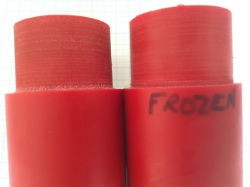Tips to Machine the Impossible
Machining Polyurethane rod could be deemed as a daunting task by some, its like trying to machine hard rubber, as you put the cut on nothing seems to happen as the material deflects then all of a sudden the tool bites and just takes a chunk out.
We decided to ask an engineer who regularly machines the stuff to get his tips. Although Anthony at B&G Engineering was keen to stress that his tips aren’t the be all and end all and other engineers may have a completely different take on the subject, his tips are a great starting point for turning polyurethane rod.
Low speed-high feed
Anthony reckoned what had worked the best for him when turning polyurethane was a low speed and a high feed, he was keen to mention that he reckoned the opposite would be true for milling, so a high speed and a low feed there.
Coolant
Plenty of coolant if you can, to keep the plastic from melting
Cutting Tools
It’s here it seems that the game is either won or lost, recommending that all tools are high speed steel and razor sharp at that. He also pointed out that they need high rake angles to knife their way through
Warning
The swarf as always, will wrap round tools etc but beware as that stuff its stronger than it looks, grabbing it and trying to break it could probably end up dragging you in.
Alternatives
Grinding is always an option, using a high grit with plenty of coolant is pretty successful but remember the grit will get clogged pretty quickly so regular attention to remove the debris from the belt or disc is essential
Freezing has been mentioned, so maybe placing the material in a deep freezer or even cryogenically freezing polyurethane could help improve its machining characteristics, although you’d have to be on your toes before it thaws.
Summary
- Low speed & high feed (opposite for milling)
- Plenty of coolant
- High speed steel cutting tools
- Razor sharp
- High rake on those tools
- That swarf is stronger than it looks
Thanks
A huge thanks to Anthony at BG Engineering Ltd in Holmewood, Chesterfield for his contribution.
Follow-up from the freezer
Having a recent brain-wave, i decided to try a little experiment, so i got 2 pieces of 90 shore polyurethane from stock and pretended i was an engineer again.

This was done on a very basic model-makers lathe but i decided to see if “freezing” polyurethane would make any difference, here’s what i noticed.
Clamping the first (unfrozen) bar into the chuck was as i suspected; the chuck key seems to turn forever and the machining result seems very rough to say the least.
Clamping the second (frozen) bar into the chuck is a pretty different reaction from the chuck key, i could feel a definite resistance and using the very same settings, the surface finish certainly seems a lot better.
This experiment was purely to see if freezing PU would have any effect so please ignore my machining skills (or complete lack of) but what i found as you can see from the photo, is that popping it in next to a bag of your supposedly five-a-day overnight seems to be definite advantage, obviously its a bit like Viagra (allegedly) in the fact that the effects would wear off after a while.










